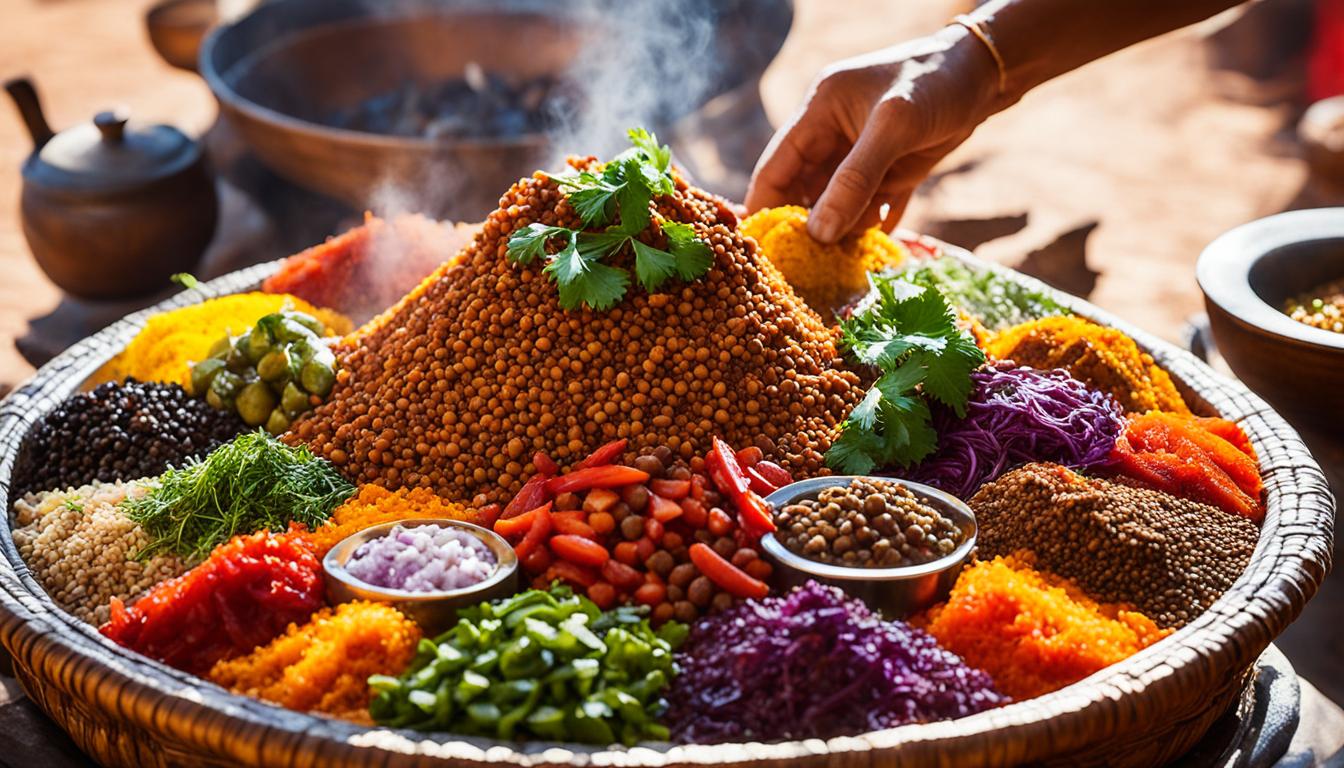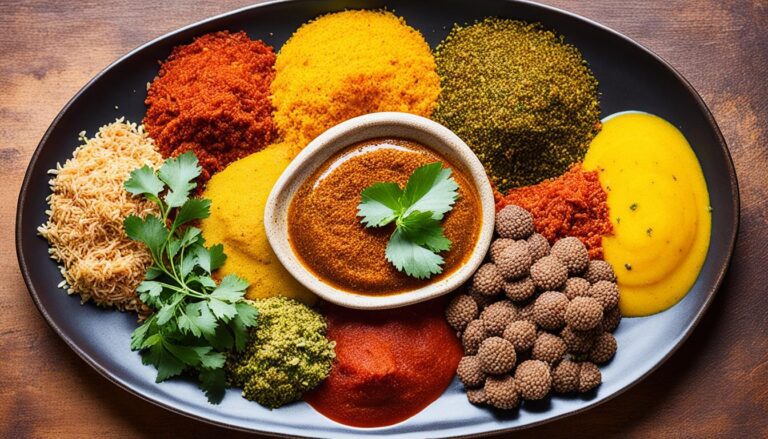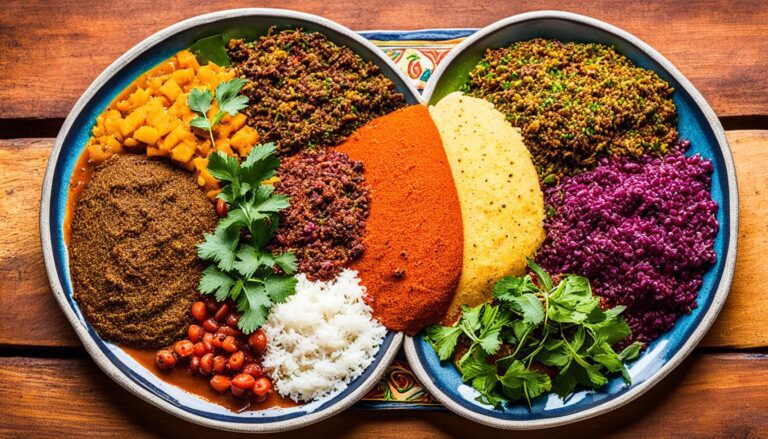Do You Eat Ethiopian Food With Your Hands?
When it comes to experiencing traditional cuisine, the way we eat can be just as important as the food itself. In Ethiopian culture, a vibrant and flavorful cuisine awaits, but have you ever wondered if it’s customary to eat Ethiopian food with your hands? Let’s delve into the fascinating world of Ethiopian cuisine and explore the intriguing answer to this question.
Key Takeaways:
- Eating Ethiopian food with your hands is a long-standing cultural tradition.
- Using injera, a sourdough flatbread, as a utensil is key to the experience.
- Eating with your hands enhances the tactile and communal aspects of the dining experience.
- Proper hygiene, such as handwashing, is important when eating with your hands.
- Eating Ethiopian food with your hands adds to the authenticity and enjoyment of the meal.
Ethiopian Cuisine: A Celebration of Flavor and Tradition
Ethiopian cuisine is a true feast for the senses, offering a delightful fusion of unique flavors and rich cultural traditions. Influenced by a diverse range of culinary influences, including Indian, Middle Eastern, and African flavors, Ethiopian food showcases a remarkable blend of spices, grains, and vegetables that sets it apart.
From injera, a spongy sourdough flatbread, to flavorful stews known as wats, Ethiopian cuisine offers a diverse and mouthwatering culinary experience. The use of spices such as berbere, a fiery blend of chili peppers, ginger, and garlic, infuses each dish with a distinct and unforgettable taste.
Tradition is at the heart of Ethiopian cuisine, and meals are often shared communally, creating a warm and inviting atmosphere. The combination of unique flavors and the traditional dining experience make Ethiopian food a culinary adventure like no other.
The Cultural Significance of Eating With Hands in Ethiopia
In Ethiopian culture, there is a deeply ingrained tradition of eating with hands that holds significant cultural value. This unique dining practice goes beyond mere convenience and adds a special touch to the Ethiopian culinary experience.
When we eat with our hands, we establish a direct connection with the food, allowing us to fully appreciate its flavors, aromas, and textures. It’s a sensory experience that brings us closer to the rich cultural heritage of Ethiopia.
Eating with hands is also a way to emphasize the importance of community and togetherness. In Ethiopian culture, sharing a meal is seen as a symbol of unity, love, and hospitality. By using our hands to eat, we engage in a tactile and intimate dining experience that fosters a sense of belonging and reinforces social bonds.

Ethiopian Dining Etiquette
When it comes to Ethiopian dining etiquette, there are a few important customs to keep in mind. Firstly, always use your right hand to eat. In Ethiopian culture, the left hand is considered unclean, as it is traditionally used for personal hygiene purposes. Therefore, using the left hand during a meal is considered impolite.
Furthermore, Ethiopians typically eat from a communal platter using injera, a sourdough flatbread, as a utensil. Tear off a piece of injera and use it to scoop up the various dishes known as wats. This shared dining experience adds to the sense of community and encourages a spirit of inclusivity.
To fully embrace Ethiopian dining etiquette, it’s important to approach the meal with an open mind and a willingness to engage in this cultural practice. By respecting these customs, you not only show your appreciation for Ethiopian cuisine but also become part of a rich cultural heritage.
How to Eat Ethiopian Food With Your Hands
Eating Ethiopian food is not only a delightful culinary experience but also an opportunity to engage in a unique dining tradition. Hand-feeding is an essential part of enjoying Ethiopian cuisine, allowing you to fully immerse yourself in the flavors and culture. In this section, we’ll guide you through the art of eating Ethiopian food with your hands.
To begin, you’ll need injera, a sourdough flatbread that serves as a versatile and edible utensil. Tear off a piece of injera, and let its soft texture entice your senses. The injera acts as the perfect vessel for experiencing the diverse flavors of Ethiopian cuisine.
Once you have your injera, it’s time to enjoy the main dishes, known as wats. Using your right hand, which is the preferred hand for eating in Ethiopian culture, scoop up a portion of the wat with a piece of injera. The spongy texture of the injera makes it ideal for soaking up the savory sauces and spices, allowing you to savor every bite.
Don’t be afraid to experiment with different combinations of injera and wats. Ethiopian cuisine offers a wide range of flavors, from mild to spicy, allowing you to create a personalized dining experience that suits your taste buds.

The tactile experience of eating Ethiopian food with your hands adds a sense of connection and intimacy to the meal. There’s a certain joy that comes from engaging your senses and feeling the textures of the food as you eat. It’s a communal experience that fosters a deeper appreciation for the flavors and aromas of Ethiopian cuisine.
So, the next time you have the opportunity to try Ethiopian food, embrace the tradition of hand-feeding. Experience the rich flavors, vibrant colors, and authentic cultural experience that Ethiopian cuisine has to offer.
Advantages of Eating With Your Hands
Eating Ethiopian food with your hands offers several advantages that contribute to a unique dining experience.
Tactile Experience: When you use your hands to eat, you engage all your senses. The act of touching the food creates a tactile experience that heightens your perception of flavors and textures. The direct contact with the food allows you to fully appreciate its richness and intricacies.
Connecting with Food: Hand-feeding establishes a personal connection between you and the meal. By using your hands, you become actively involved in the dining process, breaking bread and scooping up each flavorful morsel. This intimate connection deepens your appreciation for the food’s cultural significance and enhances your overall enjoyment.
Eating with your hands also fosters a sense of community and togetherness. In Ethiopian culture, meals are typically shared from a communal plate, encouraging conversation and bonding over a delicious spread of dishes.
So, the next time you indulge in Ethiopian cuisine, embrace the advantages of eating with your hands. The tactile experience and the connection with the food will not only elevate your dining experience but also allow you to fully immerse yourself in the rich cultural heritage of Ethiopian cuisine.
Etiquette and Hygiene Considerations
When enjoying Ethiopian cuisine and eating with our hands, it’s crucial to prioritize proper etiquette and hygiene. Ethiopian dining etiquette is ingrained in a rich cultural tradition, and observing these practices demonstrates respect for the cuisine and its people.
First and foremost, hygiene is essential. Before sitting down to a mouthwatering Ethiopian meal, it’s important to wash our hands thoroughly, ensuring they are clean and free from any potential contaminants. It’s a simple but crucial step in maintaining cleanliness and preserving the integrity of the dining experience.
To further uphold proper hygiene, we should also wash our hands after the meal. This step not only ensures personal cleanliness but also exemplifies thoughtfulness and respect for Ethiopian dining customs.
Respecting Ethiopian dining etiquette also means using the right hand for eating. In Ethiopian culture, the left hand is traditionally associated with hygienic activities, while the right hand is used for eating. By using the correct hand, we demonstrate cultural understanding and etiquette, enhancing our overall dining experience.
By embracing proper etiquette and hygiene, we can fully appreciate the cultural significance of Ethiopian cuisine. The tactile experience of eating with our hands, combined with cleanliness and respect, creates a memorable dining encounter that allows us to fully immerse ourselves in Ethiopian tradition and culinary heritage.
Conclusion
In conclusion, Ethiopian cuisine offers a truly immersive cultural experience that goes beyond just indulging in delicious flavors. By embracing the tradition of eating Ethiopian food with your hands, you can fully immerse yourself in the rich heritage and culinary customs of this vibrant country.
Partaking in authentic Ethiopian dining allows you to connect with the food on a deeper level, enhancing the overall enjoyment of the meal. The communal aspect of hand-feeding and sharing injera and wats fosters a sense of togetherness, making the experience even more memorable.
Whether you are savoring the complex flavors of doro wat, the spiced lentils of mesir wat, or the array of vegetable dishes, dining with your hands adds a tactile element that heightens the senses. It allows you to truly appreciate the unique textures, aromas, and tastes that Ethiopian cuisine is renowned for.
To fully embrace the authenticity of Ethiopian dining, it is essential to understand proper etiquette and hygiene practices. Washing your hands before and after the meal and using the right hand for eating are important customs to observe, ensuring a respectful and hygienic experience.







